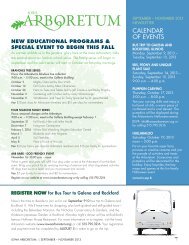New Ornamental Grasses at the Iowa Arboretum
New Ornamental Grasses at the Iowa Arboretum
New Ornamental Grasses at the Iowa Arboretum
Create successful ePaper yourself
Turn your PDF publications into a flip-book with our unique Google optimized e-Paper software.
<strong>Ornamental</strong> <strong>Grasses</strong> <strong>at</strong> <strong>the</strong> <strong>Iowa</strong> <strong>Arboretum</strong>Since 1995 when <strong>the</strong> Ames Garden Club funded a trial bed of 25 cultivars ofMiscanthus sinensis, Japanese silver banner grass, <strong>the</strong> <strong>Iowa</strong> <strong>Arboretum</strong> hasbecome known for its ornamental grasses. With <strong>the</strong> addition of a second grassborder in <strong>the</strong> perennial garden area in 2008 we now display 66 ornamental n<strong>at</strong>iveand exotic grasses -- certainly one of <strong>the</strong> most varied assemblages in <strong>Iowa</strong>.We’d like to share wh<strong>at</strong> worked and wh<strong>at</strong> didn’t with our readers and potentialvisitors.<strong>Iowa</strong> is <strong>the</strong> land of <strong>the</strong> tall grass prairie with soil and sunshine ideal for <strong>the</strong> growthof many members of <strong>the</strong> grass (Poacae) family. Grass-like plants such assedges (Carex species) and rushes (Juncus species) can also grow well, albeit inmore shaded or moist loc<strong>at</strong>ions. Our major challenge is winter hardiness – somebeauties such as Pampas grass (Cortaderia) and purple fountain grasses(Pennisetum) -- can only be grown as annuals. The <strong>Arboretum</strong> often behaveslike a pocket of USDA Hardiness Zone 4 in <strong>the</strong> midst of a Zone 5 area, so wetake some risks in incorpor<strong>at</strong>ing Zone 5 r<strong>at</strong>ed plants. However, you can be fairlyconfident th<strong>at</strong> wh<strong>at</strong> survives here will grow in your garden even in <strong>the</strong> far reachesof <strong>Iowa</strong>.Why <strong>Grasses</strong>? <strong>Grasses</strong> provide contrasting texture to broad-leaved plants and<strong>the</strong> element of movement in <strong>the</strong> garden. Taller ones add height and screening toa border and offer a green background against which to display colorfulperennials. Low maintenance <strong>at</strong>tributes include few pests and diseases and noneed for additional fertilizer. Too many nutrients can cause <strong>the</strong>m to flop. Afterestablishment, <strong>the</strong>se are also w<strong>at</strong>er-wise plants, requiring no irrig<strong>at</strong>ion.With careful choices, grasses can provide almost year-round interest. Along withconifers, grasses prevent your garden from becoming a “dead zone” punctu<strong>at</strong>edby plant markers throughout long winters. Many bloom l<strong>at</strong>e in <strong>the</strong> summer orearly fall and <strong>the</strong>ir blossoms (inflorescences) and foliage remain <strong>at</strong>tractive over<strong>the</strong> winter. Miscanthus sinensis and switchgrass (Panicum virg<strong>at</strong>um) cultivars aresome of <strong>the</strong> best choices for winter interest as <strong>the</strong>ir foliage and blooms hold well.Those with more slender foliage or earlier bloom such as <strong>the</strong> very popularFe<strong>at</strong>her Reed Grass (Calamagrostis ‘Karl Foerster’) and Purple Moor Grass(Molinia caerulea) generally look ragged by spring.Seasonal Care: The main chore is cutting back foliage once a year. CutMiscanthus and most o<strong>the</strong>r grasses down to a short stubble (3-4 inches) in l<strong>at</strong>eMarch or early April. If you have a lot of grasses, use a brush cutter or hedgetrimmer and be prepared to dispose of a “haystack”. Cool season grasses,notably Calamagrostis, start growing in March so consider cutting <strong>the</strong>m back in<strong>the</strong> fall if you typically get a l<strong>at</strong>e start on spring work. By June Calamagrostis hasgrown to its full foliage height and soon <strong>the</strong> tawny seed heads provide a newsummer show. O<strong>the</strong>r grasses such as Fescues, Sedges, and Blue O<strong>at</strong> Grass
(Helictotrichon) are almost evergreen. Use your gloved hands to pull out <strong>the</strong> oldgrowth r<strong>at</strong>her than shearing <strong>the</strong>m off.Miscanthus sinensis Cultivars: Breeders have given us over 100 cultivars fromwhich to choose. The largest we display is <strong>the</strong> aptly named ‘Silberfeder’, makinga 7-foot wide fountain with fe<strong>at</strong>hery, silvery flowers; <strong>the</strong> smallest is ‘Gold Bar’ <strong>at</strong>about 18 inches with a strictly upright physique. The fine textured, l<strong>at</strong>e floweringolder cultivar ‘Gracillimus’ or Maiden Grass holds well over winter but an earlyfrost can doom its blossoms, robbing <strong>the</strong> winter show. Earlier flowering cultivarssuch as ‘Bitsy Ben’ and ‘Nippon’ look handsome in l<strong>at</strong>e summer but don’t alwayshold over winter. We’ve also observed seedlings (undesirable) near some of<strong>the</strong>se.A few Miscanthus cultivars have fine textured foliage: examples in our collectioninclude ‘Sarabande’, ‘Gracillimus’, its varieg<strong>at</strong>ed sport ‘Morning Light’, ‘Graziella’and ‘November Sunset’. Most have wider blades. Form can be very upright as in‘Strictus’, ‘Gold Bar’, and purpurescens (Flame Grass) or fountain-like as in‘Silberfeder’ (wider than tall) with most cultivars falling between <strong>the</strong>se extremes.There are many varieg<strong>at</strong>ed forms, both green/white and green/yellow. Verticalstripes are found on ‘Morning Light’, ‘Rigoletto’, and ‘Varieg<strong>at</strong>us’. Horizontal goldbars decor<strong>at</strong>e ‘Strictus’ (Porcupine grass), ‘Zebrinus’ (not on display – not hardyfor us), ‘Kirk Alexander’, ‘Gold Bar’, and ‘Puenktchen’. Varieg<strong>at</strong>ed foliage,particularly on wide-bladed cultivars, makes <strong>the</strong> grass clump stand out in yourgarden even when not in bloom.A border of o<strong>the</strong>r grasses: Both exotic and n<strong>at</strong>ive grasses were used in a 2008n<strong>at</strong>uralistic planting designed by Ann Hutchins of Des Moines. You could call it a"no Miscanthus border" although a spectacular new varieg<strong>at</strong>ed Miscanthuscultivar, 'Gilded Tower', was allowed to sneak in. The bed was bermed andprovided with a good cover of pine bark mulch. Several varieties of fescues,varieg<strong>at</strong>ed fe<strong>at</strong>her reed grasses, switchgrasses, fountain grasses, sedges,gramas, Indian grasses, and moor grasses were selected. My personal favoritesamong <strong>the</strong>se new grasses, also admired by our visitors, are fe<strong>at</strong>ured below.To better display grasses as <strong>the</strong>y might be used in a home garden, we choseaccompaniments from among <strong>the</strong> sophistic<strong>at</strong>ed new cultivars of coneflowers(Echinacea), false indigo (Baptisia), asters (Aster), blanket flowers (Gaillardia),coreopsis (Coreopsis), salvias (Salvia), c<strong>at</strong>mints (Nepeta), bee balms (Monarda),goldenrods (Solidago), sunflowers (Heliopsis), and black-eyed susans(Rudbeckia). These are all low-maintenance plants th<strong>at</strong> blend well with grasses.I especially like Coreopsis 'Jethro Tull', several Echinacea cultivars of <strong>the</strong> ‘BigSky’ series, and Gaillardia ‘Amber Wheels’.Wh<strong>at</strong> didn’t work? Dwarf or varieg<strong>at</strong>ed varieties are often less hardy than <strong>the</strong>species. We’ve lost M. sinensis ‘Zebrinus’ and ‘Morning Light’, Purple Three-Awn (Arist<strong>at</strong>a purpurea), Nor<strong>the</strong>rn Pampas Grass (Saccharum ravennae), and
Pennisetum cultivars ‘Foxtrot’, ‘Karley Rose’, ‘Little Bunny’ and even some of <strong>the</strong>straight species alopecuroides. However ‘Morning Light’ thrives next to <strong>the</strong>Hughes Educ<strong>at</strong>ion Center and Saccharum ravennae overwintered in my Amesgarden.The <strong>Iowa</strong> <strong>Arboretum</strong> was "ahead of <strong>the</strong> curve" in fe<strong>at</strong>uring ornamental grassesfifteen years ago. The new border showcases some lesser known species andnew releases for your consider<strong>at</strong>ion. The complete listing of <strong>the</strong> <strong>Arboretum</strong>’sornamental grasses is found on our web site (www.iowaarboretum.org). We hopeyou’ll visit both <strong>the</strong> grounds and <strong>the</strong> web site to select grasses for your owngarden.



